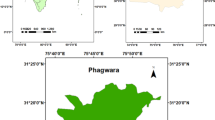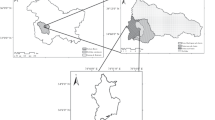Abstract
In the prediction of overland flow, infiltration is an essential component, which should be modeled accurately to achieve optimum runoff rates. Many mathematical models that simulate the details of runoff and erosion process in hillslopes, where the rill-interrill configuration significantly affects overland flow, employ Horton’s model for infiltration due to its simplicity. However, Horton’s model does not handle adequately antecedent moisture condition (AMC) of soil. In this study, the Green-Ampt infiltration model is incorporated into a physically based overland flow model, which was originally coupled with Horton’s equation in an effort to improve the overland flow model’s prediction ability. In so doing, the model used the Horton and Green-Ampt model as an infiltration component separately and simulated flow to directly compare which infiltration equation performs better with the overland flow model. Calibration using laboratory data produced good results for both Horton with NSE = 0.88 and r 2 = 0.92 and Green-Ampt with NSE = 0.90 and r 2 = 0.95 while in validation, the Horton-coupled model produced lower NSE = 0.64 and r 2 = 0.84 than the Green-Ampt which produced NSE = 0.85 and r 2 = 0.85. The results suggest that the Green-Ampt equation can improve the performance of the overland flow model with its ability to account more accurately the AMC and flow processes in the soil.




Similar content being viewed by others
References
Aksoy H, Erdem Unal N, Cokgor S, Gedikli A, Yoon J, Koca K, Boran Inci S, Eris E (2012) A rainfall simulator for a laboratory-scale assessment of rainfall-runoff-sediment transport processes over a two-dimensional flume. Catena 98:63–72
Arguelles ACC, Jung M, Pak G, Aksoy H, Kavvas ML, Yoon J (2013) Evaluation of overland flow model for a hillslope using laboratory flume data. Water Sci Technol 68:1188–1194
Beven K (2004) Robert E. Horton’s perceptual model of infiltration processes. Hydrol Process 18:3447–3460
Chahinian N, Moussa R, Andrieux P, Voltz M (2005) Comparison of infiltration models to simulate flood events at the field scale. J Hydrol 306:191–214
Chapra SC (1997) Surface water quality modeling. McGraw-Hill Book Co, Singapore
Chen CL, Chow VT (1971) Formulation of mathematical watershed-flow model. J Eng Mech Div 97:809–828
Chow VT (1959) Open channel hydraulics. McGraw-Hill Book Co, New York
Chow VT, Maidment DR, Mays LW (1988) Applied hydrology. McGraw-Hill Book Co, Singapore
Daluz Vieira JH (1983) Conditions governing the use of approximations for the Saint Venant equations for shallow surface water flow. J Hydrol 60:43–58
De Lima JLMP, Van der Molen WH (1988) An analytical kinematic model for the rising limb of overland flow on infiltrating parabolic shaped surfaces. J Hydrol 104:363–370
De Roo APJ, Jetten VG (1999) Calibrating and validating the LISEM model for two data sets from the Netherlands and South Africa. Catena 37:477–493
Deng ZQ, De Lima JLMP, Singh VP (2005) Transport rate-based model for overland flow and solute transport: parameter estimation and process simulation. J Hydrol 315:220–235
Emmett WE (1970) The hydraulics of overland flow on hillslopes. http://pubs.usgs.gov/pp/0662a/report.pdf. Accessed 5 Dec 2013
Esteves M, Faucher X, Galle S, Vauclin M (2000) Overland flow and infiltration modelling for small plots during unsteady rain: numerical results versus observed values. J Hydrol 228:265–282
Gilley JE, Kottwitz ER, Simanton JR (1990) Hydraulic characteristics of rills. Trans ASAE 33:1900–1906
Govindaraju RS, Jones SE, Kavvas ML (1988a) On the diffusion wave model for overland flow, 1. Solution for steep slopes. Water Resour Res 24:734–744
Govindaraju RS, Jones SE, Kavvas ML (1988b) On the diffusion wave model for overland flow, 2. Steady state analysis. Water Resour Res 24:745–754
Govindaraju RS, Kavvas ML, Tayfur G, Krone RB (1992) Erosion control of decomposed granite at Buckhorn Summit. Final report, California Department of Transportation, USA
Gronsten HA, Lundekvam H (2006) Prediction of surface runoff and soil loss in southeastern Norway using the WEPP hillslope model. Soil Tillage Res 85:186–199
Gupta HV, Kling H, Yilmaz KK, Martinez GF (2009) Decomposition of the mean squared error and NSE performance criteria: Implications for improving hydrological modelling. J Hydrol 377:80–91
Kavvas ML, Govindaraju RS (1992) Hydrodynamic averaging of overland flow and soil erosion over rilled hillslopes. In: Walling DE, Davies TR, Hasholt B (eds) Chengdu symposium, 1992, erosion, debris flows and environment in mountain regions, IAHS Publ., Wallingford, pp 101–111
Lee KT, Huang JK (2013) Runoff simulation considering time-varying partial contributing area based on current precipitation index. J Hydrol 486:443–454
Liu QQ, Chen L, Li JC, Singh VP (2004) Two-dimensional kinematic wave model of overland flow. J Hydrol 291:28–41
Liu D, Tian F, Hu H, Hu H (2012) The role of run-on for overland flow and the characteristics of runoff generation in the Loess Plateau, China. Hydrol Sci J 57:1107–1117
Mein RG, Larson CL (1973) Modeling infiltration during a steady rain. Water Resour Res 9:384–394
Mishra SK, Tyagi JV, Singh VP (2003) Comparison of infiltration models. Hydrol Process 17:2629–2652
Moriasi DN, Arnold JG, Van Liew MW, Bingner RL, Harmel RD, Veith TL (2007) Model evaluation guidelines for systematic quantification of accuracy in watershed simulations. Trans ASABE 50:885–900
Morris EM (1978) The effect of the small-slope approximation and lower boundary condition on the solutions of the Saint Venant equations. J Hydrol 40:31–47
Morris EM, Woolhiser DA (1980) Unsteady one-dimensional flow over a plane: partial equilibrium and recession hydrographs. Water Resour Res 16:355–360
Nahar N, Govindaraju RS, Corradini C, Morbidelli R (2004) Role of run-on for describing field-scale infiltration and overland flow over spatially variable soils. J Hydrol 286:36–51
Pit R, Lantrip J, Harrison R, Henry C, Xue D (1999) Infiltration through disturbed urban soils and compost-amended soil effects on runoff quality and quantity. U.S. EPA Publications. http://www.epa.gov/nrmrl/pubs/600r00016.html. Accessed 5 Dec 2013
Ponce VM, Li RM, Simons DB (1978) Applicability of kinematic and diffusion models. J Hydraul Eng 104:353–360
Rawls W, Brakensiek D, Miller N (1983) Green-Ampt infiltration parameters from soils data. J Hydraul Eng 109:62–70
Rossman LA (2009) Storm water management model user’s manual version 5.0. U.S. EPA Publications. http://www.epa.gov/nrmrl/pubs/600r05040.html. Accessed 5 Dec 2013
Tayfur G (2007) Modelling sediment transport from bare rilled hillslopes by areally averaged transport equations. Catena 70:25–38
Tayfur G, Kavvas ML (1994) Spatially averaged conservation equations for interacting rill-interrill area overland flows. J Hydraul Eng 120:1426–1448
Tayfur G, Kavvas ML (1998) Areally-averaged overland flow equations at hillslope scale. Hydrol Sci J 43:361–378
Turner ER (2006) Comparison of infiltration equations and their field validation with rainfall simulation. Master thesis, University of Maryland, College Park
Xu CY (2003) Hydrologic models. Uppsala University Department of Earth, Air and Water Sciences, Uppsala, Sweden
Yoon J, Kavvas ML (2000) Spatial averaging of overland flow equations for the hillslope with rill-interrill configuration. In: Proc. of the 4th Int. Conf. on Hydro-Science and Eng. (ICHE). Seoul
Acknowledgments
This research was supported by the Basic Science Research Program through the National Research Foundation of Korea (NRF) funded by the Ministry of Education (NRF-2013R1A1A4A01007676) and a research grant from Korea University.
Author information
Authors and Affiliations
Corresponding author
Rights and permissions
About this article
Cite this article
Mallari, K.J.B., Arguelles, A.C.C., Kim, H. et al. Comparative analysis of two infiltration models for application in a physically based overland flow model. Environ Earth Sci 74, 1579–1587 (2015). https://doi.org/10.1007/s12665-015-4155-7
Received:
Accepted:
Published:
Issue Date:
DOI: https://doi.org/10.1007/s12665-015-4155-7




